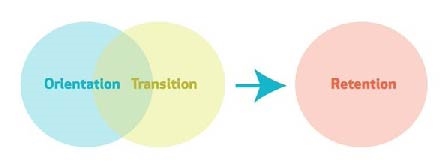The field of orientation, transition and retention is an organizationally complex and practical field in which professionals routinely attempt to interpret simplistic viewpoints.
In the viewpoint of organizational theory, orientation, transition, and retention cannot be categorized or understood as a simple issue or approached through simple structures. Orientation, transition, and retention are highly interconnected concepts, therefore must be approached through a complex lens (Snowden & Boone, 2007; Chillers, 1998).
NODA’s philosophy toward orientation, transition, and retention is to blur the traditional independent fields known more specifically to orientation in that transition is the continuous process leading toward orientation and retention. Contemporary professionals in orientation, transition, and retention must recognize the intersectionality of orientation, transition, and retention to demonstrate the knowledge, skills and abilities needed to successfully support students.
To further define and create understanding of orientation, transition, and retention, NODA defines each in the following manner:

Orientation is the deliberate communication, programmatic and service efforts designed to facilitate the transition of new students to the institution; prepare students for the institutions educational opportunities and student responsibilities; begin the integration of new students into the intellectual, cultural, and social climate of the institution; and support the families, and other support networks of the new student (CASHE, 2009).
Transition is the process students go through when entering and continuing through a particular institution of higher education and/or entering the same institution for a new purpose. This may include, but is not limited to, entering as a first-year student, transferring from a different institution, and/or entering an institution for a subsequent degree (e.g., entering graduate school). Successful transition includes facilitating or creating an environment through intentional experiences in which students develop a sense-of-belonging which results in students achieving their goals and engaging families which results in student integration into the institution and, ultimately, in retention and/or achievement of personal educational objectives.
Retention is student progression through higher education, focusing primarily on student persistence (i.e., term to term) through the beginning of the second year at the same institution, with the goal being graduation from that institution and/or achievement of personal educational objectives. Retention is one outcome/measure/byproduct of successful student orientation and transition, which should involve academic and social integration processes.
Orientation, Transition, & Retention Programs
Below is a list of possible orientation, transition, and retention programs and/or initiatives. This is not an exhaustive list and could include other program types depending on the institution.
- Single or multiple day “traditional orientation programs”
- Welcome Weeks
- Extended orientation (e.g., orientation camps)
- Population-specific programs (e.g., first-generation college students, international students, out of state students, commuter students, etc.)
- Outdoor/wilderness orientation programs
- Special-interest & special-population orientation programs
- Pre-orientation programs (e.g., Summer Bridge programs)
- Online orientation programs
- Parent/family orientation programs
- Orientation courses/first-year seminars/workshop series
- Enrollment management strategies
- Course registration labs
- Mentorship programs
- Living Learning Communities
- Properly advising students
- Ongoing parent and family engagement
- Enrollment analytics and visualizations
- Pathway programs
- Residential curriculums
- Access & Accommodations
- Strategies of communication (e.g., software platforms, targeted newsletters)
Terminology Resource Guide
A support tool for international attendees to NODA conferences
NODA: An Association for Orientation, Transition, and Retention in Higher Education strives to create peer-to-peer learning opportunities for its members. The association uses online connection platforms, conferences, and webinars to foster experiential learning.
The NODA Leadership has acknowledged that sometimes the terminology used by the membership may be misunderstood or unfamiliar to international members. NODA’s Global Initiatives Committee is working toward developing a means for all members of the association to understand the various terminology related to new student transition used in other regions of the world. In the interim, this guide has been developed for international members to better equip themselves with a basic understanding of the terms frequently used by membership during conferences and other engagement opportunities.
Further Support
If, throughout your communication within NODA, you identify language used that you have not heard before or is not included in this guide, please always feel like you can ask the speaker questions about the terms used. This creates a valuable learning opportunity for both you, the speaker, and others participating in the session – just like in Orientation, if you have the question, likely others do, too!
You are encouraged to also email the NODA staff with a description of the event and the terminology discussed, at noda@umn.edu. This will allow the association to update the guide for future use.

